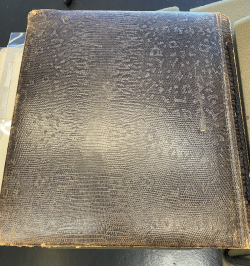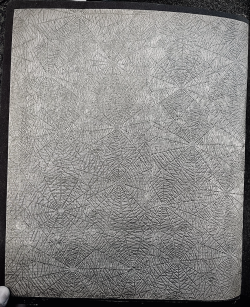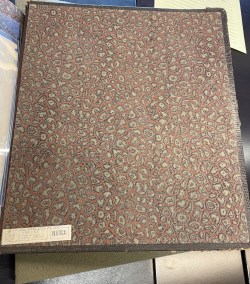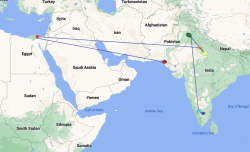User:Anjaligu: Difference between revisions
(Created page with "==British Soldier's Photo Album from Journey through Colonial India== This album was curated by a British soldier from the years 1930 - 1935. The photographs journal the British soldier’s perspective of colonial India. There are 49 pictures of various subjects within modern day India and Pakistan and there are 2 pictures of Port Said, Egypt. Intricate hand-calligraphed descriptions of the photo subject matter was detailed underneath each picture. The descriptions rang...") |
No edit summary |
||
| Line 18: | Line 18: | ||
The book itself has a plastic snake leather texture in a dark brown. Yellowed stuffing sticks out of the edges of the frayed cover. There is a thick black rope securing the binding and the inside pages have an animal print pattern. It appears to be a store-bought album that was then carefully hand filled with pictures and annotated. The brand of album, Kodak, is a popular global photography company to this day. The paper is thick and has the feel of cardstock. In between each page is a vinyl sheet designed to protect the contents of the album. The vinyl sheets are impressed with spider webs and spider designs, offering a tactile finish and grip with which to turn pages. | The book itself has a plastic snake leather texture in a dark brown. Yellowed stuffing sticks out of the edges of the frayed cover. There is a thick black rope securing the binding and the inside pages have an animal print pattern. It appears to be a store-bought album that was then carefully hand filled with pictures and annotated. The brand of album, Kodak, is a popular global photography company to this day. The paper is thick and has the feel of cardstock. In between each page is a vinyl sheet designed to protect the contents of the album. The vinyl sheets are impressed with spider webs and spider designs, offering a tactile finish and grip with which to turn pages. | ||
[[File:Book.png|thumb|250px| | [[File:Book.png|thumb|250px|right|The cover of the photo album.]] | ||
[[File:spiderweb.png|thumb|250px| | [[File:spiderweb.png|thumb|250px|right|Vinyl sheet protectors with spider web designs. Note that the image is edited to show imprints more clearly.]] | ||
[[File:kodak.png|thumb|250px| | [[File:kodak.png|thumb|250px|left|Small Kodak Company iconography on back inside flap.]] | ||
The images range from portraits to close ups of intricate architecture. The photographs transition from glossy to matte over the course of the album. The photograph paper is thick so that when running a finger over the surface of the entire page, it can be clearly discerned what is photographed and what is the original album book paper. Each photograph is meticulously glued to the center of the dark pages. The gluing is seamless and there are thick paper brackets over the corners of the photos. Underneath each photograph is a carefully hand-calligraphed description of the photo. The ink of these inscriptions is white and has a raised texture on the surface of the page. The calligraphy is intricate and looks like it was time-consuming. These descriptions range from simple geographical location to personal commentary and inside jokes. | The images range from portraits to close ups of intricate architecture. The photographs transition from glossy to matte over the course of the album. The photograph paper is thick so that when running a finger over the surface of the entire page, it can be clearly discerned what is photographed and what is the original album book paper. Each photograph is meticulously glued to the center of the dark pages. The gluing is seamless and there are thick paper brackets over the corners of the photos. Underneath each photograph is a carefully hand-calligraphed description of the photo. The ink of these inscriptions is white and has a raised texture on the surface of the page. The calligraphy is intricate and looks like it was time-consuming. These descriptions range from simple geographical location to personal commentary and inside jokes. | ||
Revision as of 02:12, 30 April 2022
British Soldier's Photo Album from Journey through Colonial India
This album was curated by a British soldier from the years 1930 - 1935. The photographs journal the British soldier’s perspective of colonial India. There are 49 pictures of various subjects within modern day India and Pakistan and there are 2 pictures of Port Said, Egypt. Intricate hand-calligraphed descriptions of the photo subject matter was detailed underneath each picture. The descriptions range from simple geographical location to personal commentary and inside jokes.
Many of the photographs are of scenic views and architecture and local artistry. There are few depictions of local everyday life and people. Of the few, the portraits appear particularly staged. The book was curated with purpose and care and offers insight into a colonizer’s perspective of his presence in a colonized state.
The Context
This album contains pictures from 1930 - 1935. Colonialism in India ended in 1947, so these photographs were obtained pre-independence. Importantly, the pictures include places in both modern day India and Pakistan as they were not yet partitioned at that point.
Photography spread early on in South Asia and German photographers were among the pioneers of early Indian photography. There are records of German photographic studios appearing as early as 1850. [citation needed]
At the time of the creation of this specific album, it was fashionable to encapsulate journeys through images, much as it is now, and the British Crown would give soldiers time off from service to photograph colonized areas. These photographs were used as information and representation of the colony. While the identity of the British soldier who created this album remains unknown, much can be extrapolated about his travels, perspective, and interests given the content of the book and the time period and context within which it was created.
The Physical Book
The book itself has a plastic snake leather texture in a dark brown. Yellowed stuffing sticks out of the edges of the frayed cover. There is a thick black rope securing the binding and the inside pages have an animal print pattern. It appears to be a store-bought album that was then carefully hand filled with pictures and annotated. The brand of album, Kodak, is a popular global photography company to this day. The paper is thick and has the feel of cardstock. In between each page is a vinyl sheet designed to protect the contents of the album. The vinyl sheets are impressed with spider webs and spider designs, offering a tactile finish and grip with which to turn pages.



The images range from portraits to close ups of intricate architecture. The photographs transition from glossy to matte over the course of the album. The photograph paper is thick so that when running a finger over the surface of the entire page, it can be clearly discerned what is photographed and what is the original album book paper. Each photograph is meticulously glued to the center of the dark pages. The gluing is seamless and there are thick paper brackets over the corners of the photos. Underneath each photograph is a carefully hand-calligraphed description of the photo. The ink of these inscriptions is white and has a raised texture on the surface of the page. The calligraphy is intricate and looks like it was time-consuming. These descriptions range from simple geographical location to personal commentary and inside jokes.
The inscriptions lend themselves to an understanding of who the book is meant for. It appears to attempt to share a sense of familiarity with a viewer. There is minimal damage to the inner pages of the book while the cover took the brunt of the wear and tear. Thus, the content is very well protected and preserved. It contributes to the sense of memorialization and intimacy of the content. However, this is not to say that the content is without oppressive colonial tendencies: just that it was deeply valued by the creator.
The Content
The content of this album includes a wide variety of subject matter, ranging from architecture and artistry to portraits. The selection of photographs of architectural subject matters is extensive and includes the structures that are the most famous to this day, including the Taj Mahal, the Qutb Minar, and prominent locations. Other particular monuments he chose to capture include the likes of churches, religious structures, and tombs. The photographer was interested in the close up artistry involved in the creation of these buildings and sought to capture images of arches, pillars and stonework.
In addition to architectural photography, there were photographs of camels, waterfall scenes, and boats on rivers. These subjects seem to be of particular interest to the photographer - there are four separate photographs of camels and one with a close up of the camel’s head and the special caption, “Our friend the camel.” This seems to be comical and perhaps an inside joke among friends. INSERT CAMEL PHOTO HERE
There were a few portrait photographs within the album as well. People are shown in various ways: from candid in-motion photographs to staged-looking photographs. In one particular photograph of note, the photographer was interested in a scene of two adults and one young child cleaning pots by a well in Karachi. There is a camel and horse drawn carriage in the background and there is writing in Urdu painted onto the walls of a building. A cow sticks its head into the frame of the photograph in the foreground. This is the only view a reader is offered of everyday life in the album: there are no depictions of homes, family interactions, food, or markets in the album. Thus, there is a myopic view of a culture and community.
The creator of the album carefully documents all the places he travels in inscriptions underneath each photograph. His descriptions are largely informational and document a rather convoluted travel journey if the presentation of photographs is supposed to be chronological. Traveling back and forth between Karachi and Delhi multiple times and then to various other locations, this photographer traveled great distances including all the way to Port Said in Egypt and Mysore in Karnataka. INSERT MAP THINGY HERE
The final section of the photo album has professionally taken photographs carefully wrapped in plastic tucked before the back cover of the album. These photographs appear to be taken by a professional photographer and purchased and curated by the creator of the album. These photographs are of various buildings and closeups of various artistic stonework. The one exception is of a group photograph of approximately 100 uniformed men. The words, “Indian Technical Section Karachi 1930” are hand-written in blue ink.
The inscriptions throughout the album demonstrate that this is a personal tome meant to be shared with others. There is a sense of familiarity with a viewer but it is also understandable for someone who didn’t know much about the trip. They contribute a sense of memorialization and intimacy to the content. However, this is not to say that the content is without oppressive colonial tendencies: just that it was deeply valued and curated by the creator.
